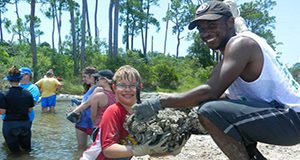Abstract
“Living shoreline” is a term that describes coastal shoreline stabilization interventions that rely on natural elements such as native vegetation and oyster reefs to protect property. Living shorelines typically involve construction or placement of materials within state waters (public lands that occur waterward of the mean high tide line). The Florida Department of Environmental Protection and other entities regulate the placement of living shorelines through a permitting process to ensure project activities do not conflict with the public interest. To streamline the approval process for environmentally beneficial projects such as living shorelines, the DEP has defined an exemption for small-scale living shoreline projects that meet certain criteria. This 17-page fact sheet written by Savanna Barry, Sara Martin, and Eric Sparks and published by the UF/IFAS Florida Sea Grant College Program provides a guide to completing the exemption forms.
http://edis.ifas.ufl.edu/sg187
Updated August 2020 to include information about updated Department of Environmental Protection form.
Unless otherwise specified, articles published in the EDIS journal after January 1, 2024 are licensed under a Creative Commons Attribution-NonCommercial-NoDerivs 4.0 International (CC BY-NC-ND 4.0) license.

